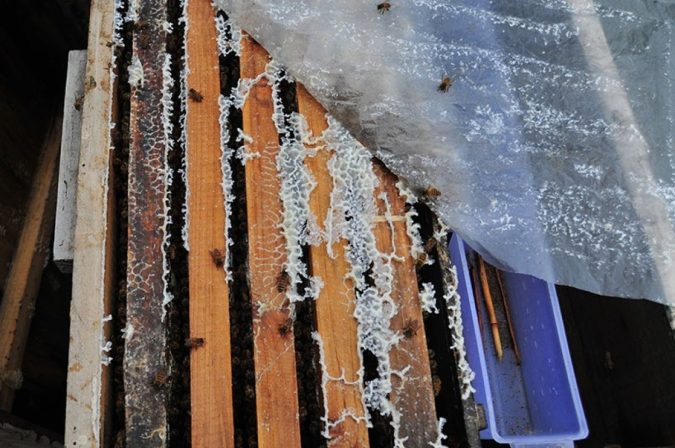Download the Feeding Honey Bees PDF
Zachary Huang
Department of Entomology
Michigan State University
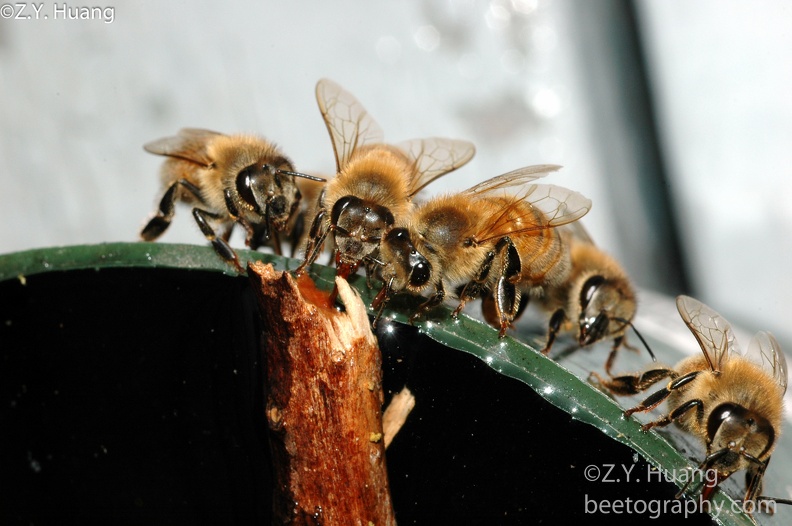
Introduction
Honey bees, like all other animals, require essential ingredients for survival and reproduction. Most of what we know about honey bee nutrition was learned from the 1950s through the 1970s; only during the last few years have we started to pay attention to honey bee nutrition again. Honey bees require carbohydrates (sugars in nectar or honey), amino acids (protein from pollen), lipids (fatty acids, sterols), vitamins, minerals (salts) and water. Additionally, these nutrients must be present in the right ratios for honey bees to survive and thrive.
Sugar
Like other animals, honey bees need carbohydrates as an energy source. Carbohydrates are converted to glucose or fructose, either of which are used to produce energy directly. Aside from being used as an energy source, glucose can also be converted to body fats and stored. Nectar is the main source of carbohydrates for honey bees. The amount of nectar needed per colony depends on how concentrated the sugars are in the nectar. A worker bee needs 11 milligrams (mg) of dry sugar each day, which translates to about 22 microliters (μl) of 50% (1:1 ratio) sugar syrup per bee per day. One teaspoon full of 50% syrup is about 5 milliliters (ml), which provides enough food for 227 bees for a day. A colony with 50,000 bees therefore needs 1.1 liters (about 2 pounds) of 50% sugar syrup per day, or almost 700 pounds of food per year. Most nectars contain less than 50% sugar, so the amount of nectar to support a large colony is even greater than 700 pounds per year.
Feeding Bees Sugar
At times, you may need to provide food to honey bees so that they do not starve. This includes when packages are first installed, or when colonies are small or getting established. You can provide supplemental food in the form of honey in combs or as a sugar syrup. A 3-pound (lb) package should receive at least two deep frames of honey or 2 gallons of syrup, which will provide enough food for about 2 weeks. If colonies are started with foundation only, more food should be provided because one pound of wax costs about 8 pounds of honey to produce. In the spring and early summer, use thin sugar syrup. Thin syrup mimics a honey flow from plants, and queens will be stimulated to lay eggs. Thin sugar syrup should be 50% (l lb of sugar to 1 lb of water).
Fall presents another time for providing food to bees. During a nectar dearth, which would be around August or September in Michigan, bees could starve due to the lack of floral resources. In Michigan, if you take all the honey from a colony, then you must provide enough food for them to winter. A typical colony will need from 70 to 100 pounds of honey to make it through winter. This translates to one deep super of honey plus three to four deep frames in the lower box. If you use medium supers, then you need two medium supers full of honey plus two to three medium frames in the lower box. Finish feeding by Oct. 1. At this time, syrup should be at least 66%, with 2 parts of sugar to 1 part of water. This is because bees do not have enough time (and high ambient temperature) to remove the water to make the syrup into honey (about 18% water). Providing thicker syrup will reduce the amount of work bees need to do.
You can provide syrup to bees via several methods. You can insert frame feeders, which are shaped like a frame of comb, into the brood box between other frames. You also can place hive top feeders on top of the colony to let bees go up and drink the syrup, or set glass jar feeders just outside the hive but near the entrance. Finally, you can set a bucket feeder on top of the hive and over the inner cover hole to provide to bees. Usually a hole is cut in the lid of the bucket and a fine mesh screen is glued over to provide bees access to syrup. Base the type of feeder you use on how much food you need to feed and how often you can refill the feeder.
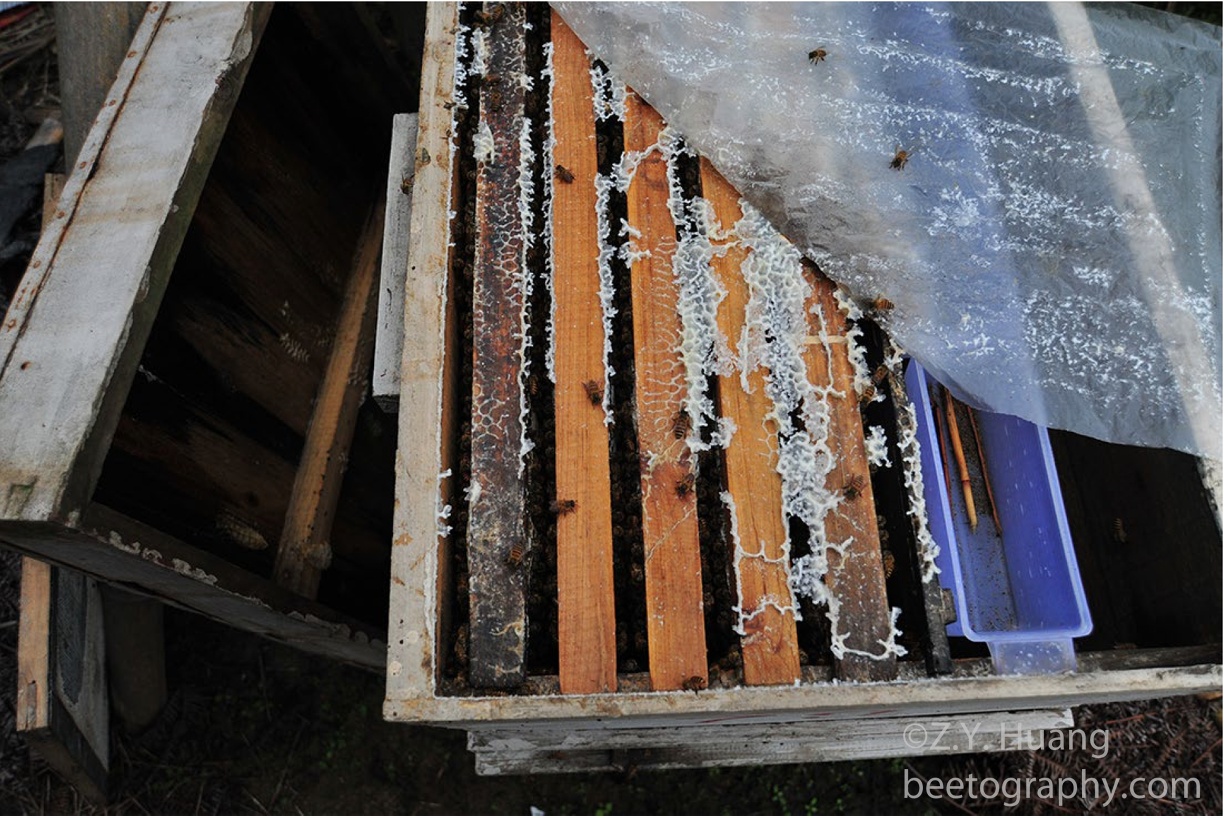
Pollen
Pollen provides bees with protein, lipids, vitamins and minerals. Proteins are made up of amino acids. All animals need essential amino acids, which must be obtained externally and cannot be synthesized by animals. Honey bees also need the same 10 amino acids as other animals (for example, humans). These amino acids are obtained from pollen only, because honey bees do not have any other sources of protein. Pollen collection by a colony ranges from 10 to 26 kilograms (kg) per year.
Pollen is mixed with nectar and bee secretions to produce “bee bread,” which goes through lactic acid fermentation. Rearing one larva requires 25–37.5 mg protein, equivalent to 125–187.5 mg pollen.
Trapping bee pollen
You can purchase bee-collected pollen from suppliers, but a risk of bringing in diseases and pests through pollen exists. Another option is to trap your own bee pollen using pollen traps. Pollen traps are devices placed under or in front of hives, with holes just large enough to allow bees in but not large enough to let bees with pollen in. You can make a trap by fixing a piece of hardware cloth with six meshes (6 holes per inch), or purchase commercial traps. The cheapest one, about $15 each, is a drawer that sits in front of a beehive. Harvest pollen every 1 to 2 days and store it frozen inside zip-close bags. You can mix the pollen with sugar syrup and provide it to bees in the spring. Bee-collected pollen has been shown to be superior to any type of pollen substitute.
Pollen substitute for bees
A good pollen substitute for honey bees should have the same features as a good pollen: 1) palatability (is readily consumed), 2) digestibility (is easily digested) and 3) balance (contains correct amino acid balance and enough crude proteins). Currently, there are at least six commercial pollen substitutes for honey bees in the U.S.: AP23, Bee-Pol, Bee-Pro, Feed-Bee, MegaBee and Ultra Bee.
Ultra Bee or MegaBee seem to be the most popular with beekeepers. Since AP23 is new, there are no published tests on it. Beekeepers reported similar acceptance and performance of AP23 as to MegaBee.
Studies are still being underway to find the optimal ratio of fat to protein in a substitute. For bumble bees, the best ratio of fat to protein is between 1:5 and 1:10. This might mean that most substitutes in the market today are too low in fat and you should consider adding 10% vegetable oil to the pollen substitutes.
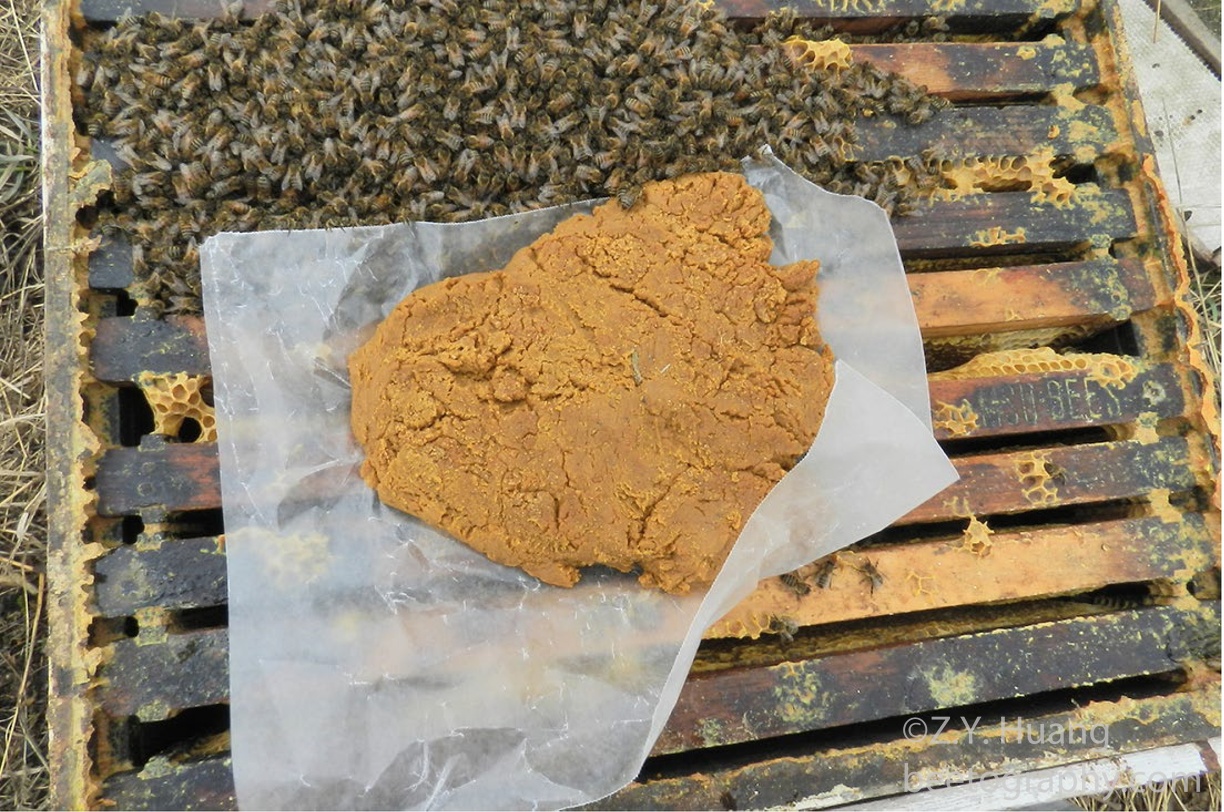
Feeding bees pollen
Feed pollen or its substitutes around mid-February to early March in Michigan. This will stimulate brood production and colonies will be ready to be split by late April. Provide at least 2 pounds in patties above brood nests on a wax paper. (To prepare patties, mix dry substitute powder with equal amounts of sugar. Then add 50% sugar syrup to make a paste-like consistency.) Bees will be desperately seeking protein sources in April and May when it is warm enough but few flowers are open yet. They may seek out any powder that looks like pollen. Bees have been seen loading up ground corn in bird feeders in the spring, even though these powders will not provide good protein to bees. Some beekeepers also provide pollen or substitutes to bees during the dearth in August and September. They claim this will build the colonies up so that they get a larger crop of goldenrod honey and bees will winter better. Feeding bees before wintering (in October and November) does not seem to help the colonies because this extends brood rearing. Any workers involved in brood rearing will not survive the winter.
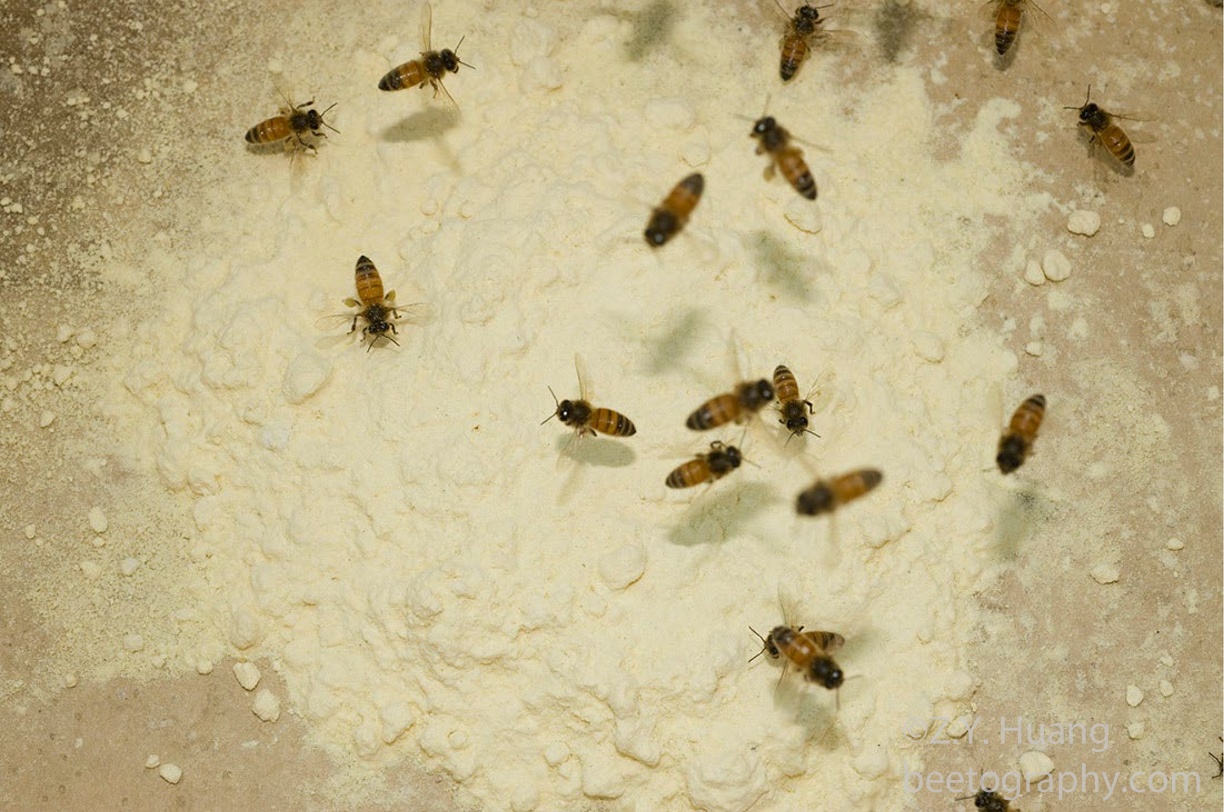
Water
Honey bees forage for water for two purposes. One is to use it to dilute honey so that honey can be added to brood food. The second is to use water to cause evaporative cooling by fanning over a thin layer of water when the ambient temperature is over 35 °C. During wintertime, bees have enough water from condensation over the inner cover. This often may produce too much water, which can drip on the cluster and kill bees if there is not adequate ventilation. When bees have a choice, they usually prefer water with some salts (for example, they’ll choose a swimming pool over a lake). A recent study showed that bees in the laboratory preferred water with 0.15– 0.3% salt (NaCl).
It is a good idea to provide water to bees during summer, with 0.1–0.2% edible salt added. (One teaspoon of salt to 1 gallon of water makes 0.11%. Use uniodinated salt if possible.) You must do this early (around mid-April in Michigan) so that bees will get used to your water source. Otherwise, they will establish their own source and go there instead of to yours. Provide some sort of floating device to keep bees from drowning. Keep replenishing the water source as needed. Never let it run dry or bees will find a new water source.
Conclusions
Honey bees can obtain all of their nutrients naturally if bees are in a setting that has sufficient floral resources. There has to be a mutualistic relationship between honey bees and humans – we provide them with shelter, care and nutrition when necessary. In return, we use them for pollination, and when there is a surplus, we remove some honey as a reward. Enjoy bees and their sweet reward!

